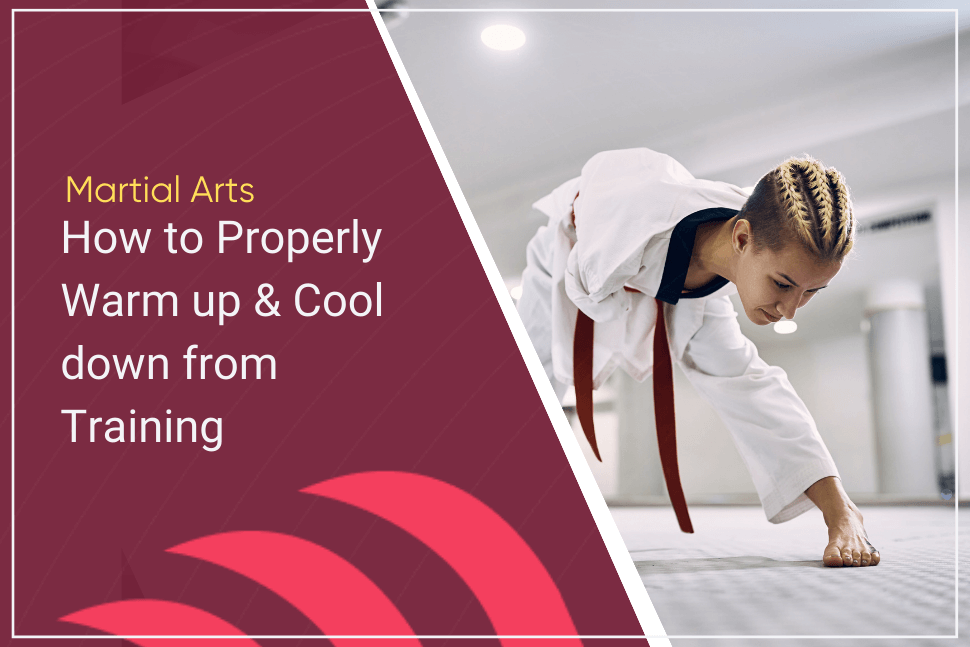For many people, properly warming up before a martial arts class is often the most boring part of the entire training session. They understand the necessity but will often find different ways to achieve the goal of loosening their muscles and increasing their heart rate so they can be adequately prepared for an intense training session.
Warming up before any kind of workout is important because it prepares your body for an increase in the type of strenuous activity that it is about to endure. As your heart rate begins to rise, your muscles become more pliant, allowing for increased dexterity. As the joints begin moving, the joint capsules fill up with lubricating fluid that helps them move easier. All of these factors combine to help improve and optimize overall athletic performance while reducing the risk of injury.
There are several ways to achieve this goal, but not all of them are necessary or relevant in preparing for a martial arts class. Performing calisthenics is a prime example. While various exercises such as jumping jacks, sprints, and push ups will get the heart pumping, they don’t do much to prepare your body for a martial arts workout. It makes a lot more sense from a practical point of view to incorporate as many sport-specific movements as needed to prepare for class.
Warming up for Martial Arts Training
A proper warm-up routine should be relevant to the sport and target specific muscles that are used during training. As you progress from lower to higher intensity, try to only do enough to increase muscle and core temperature so you don’t drain a lot of energy. Athletic performance could be hindered if your body temperature rises too quickly. Instead, your intensity should gradually increase. It’s also better to have a longer warm up in cold weather because of stiff joints and contracted muscles.
Given that most classes usually only run an hour to an hour and a half, there isn’t a lot of time that can be dedicated to a lengthy warm-up routine. It’s common for martial arts gyms to give warm-up routines that generally last between five and ten minutes at a high enough intensity to properly prepare the body for class.
There are two different types of warm-up routines in athletics: general and specific.
The two different types of warm-up routines in athletics are categorized into general and specific. A general warm-up routine aims to get the body functioning as it normally would in preparation for general exercise and strenuous activities, whereas a specific warm-up routine aims to prepare the body for what lies ahead in class or competition.
General Martial Arts Warmups
The purpose of a general warm up is to loosen your joints and muscles while boosting your circulatory and nervous systems so the body can function properly without further risk of injury. The idea is to raise your heart rate by around 50 percent. General warm ups are good for ordinary exercise routines such as biking and running, but they aren’t ideal for preparing for a martial arts class.
Both active and passive stretching can play a part in most warm-up routines, but the movements mostly comprise basic calisthenics. Some basic examples of exercises that make up a general warm-up routine are bodyweight squats, pushups, planks, and burpees.
Sport-specific Martial Arts Warm ups
Sport-specific warm-up routines, also referred to as dynamic stretching, are when you perform sport-specific motions for around 10 to 15 repetitions that focus on certain muscle groups. Sport-specific warm-up routines still follow the goals and guidelines of a general workout, except the types of drills and exercises performed are actually relevant to the sport.
Here are a few common examples of dynamic stretching, or sport-specific warm ups:
Partner drills
Partner drills are a fun and effective way to learn or review concepts that are relevant to the material that is covered in class, and to also improve timing, accuracy, and balance.
Position drills
Wrestling position drills are performed with a partner to get people accustomed to keeping their balance while quickly changing positions. One common drill is for someone to steady themselves in the “turtle” position while you face the opposite direction. From there, you rest your chest onto their back while their hands are gripped behind them. Once you establish a solid base, you will then quickly rotate your entire body from one side to the other. The purpose of this drill is to improve balance and quickness.
Flow drills
Grappling flow drills are similar to position drills but are used to get people familiar with how to get out of bad positions on the ground. For example, you will start in your partner’s guard, and from there you will go through the guard-passing motions until you advance to half guard, then side control, then full mount. The person on the bottom then performs a sweep so they end up in your guard, and the cycle continues.
Focus mitts
Hitting the focus mitts is an activity that everybody seems to enjoy regardless of skill set. You strap on the boxing gloves while the other slips the focus pads over their hands. Your partner will then give you verbal commands telling you which punching combinations to throw. It’s a great way to increase punching speed, accuracy, and learn new combinations that are then applied during sparring sessions.
Pummeling
Pummeling drills are exercises that will teach you how to establish under hooks from your opponent to secure a better position. Typically, both of you will begin with one over hook and one under hook, called the 50/50 or neutral position. Both of you will then focus on the sliding motions required to turn an overhook into an under hook, and the cycle continues.
Solo drills
Solo drilling is another common way to practice movements and better prepare for class. It allows you to work at your own pace to improve different movements and build muscle memory. Another good thing about them is that some of them can also be practiced at home.
Rolls
Forward and backward somersaults, or rolls, are a common warm-up activity because it simulates a few movements that are normally performed in jiu jitsu. Going forward, you roll your shoulder over the matt and let your head and body follow until you are back on your feet. Performing a backward roll requires you to move your head to the side while maintaining balance as you roll over your shoulder until you land on your knees.
Sprawls
Sprawling drills help you get better at defending takedowns and play a great substitute for the effectiveness of burpees. Unlike burpees, the sprawling motion is more explosive. To perform a sprawl technique from a standing position, you have to gracefully throw your legs backward while pointing the hip of your lead leg towards the mat and reducing the risk of impact with your hands. Burpees, on the other hand, are performed when you first place both hands on the mat before sprawling your legs, and your entire body remains off the ground before exploding back up.
Break falls
Break falls are drills that are seen in wrestling and jiu jitsu classes that teach you how to reduce the risk of injury by mitigating the impact sustained from a takedown. The drill is often performed by falling backward as if to perform a somersault while your hands slap the mat a split second before your body lands. The drill continues once the backward somersault is completed.
Shadowboxing
Shadowboxing is a great dynamic drill because it gets the heart rate going while working all the muscles that are used in striking. The drill is simple: you practice throwing combinations of punches and kicks as you would if an opponent was standing in front of you. Shadowboxing also allows you to work on your head movement, practice level changes, and work on breathing cadences.
Cooling down After Martial Arts Training
Cool downs are often overlooked and underutilized, but they also play an important role in post-workout recovery. Light activities such as jumping rope and shadow boxing are a couple of ways that martial artists use to cool down after an intense training session. The routines also usually consist of engaging in light activities along with active and passive stretching that assist with recovery from the inevitable buildup of lactic acid. Not only can cool-down routines assist with recovery, but they can also improve your overall posture while increasing your flexibility and balance.
Recent studies have also suggested that static stretching could be counterintuitive in that it may inhibit overall athletic performance, according to several studies. It’s never a bad idea to stretch, but doing so for these purposes wastes time during class.
Stretching helps loosen the lactic acid by raising muscle temperature, which in turn increases blood flow and oxygen supply to the muscles and heart and brain. It is also a good idea to stretch in the morning after waking up.
Active stretching
Active stretching doesn’t require a partner or external forces because you are using your own muscles for resistance. When you perform a basic stretch like the toe touch, you are engaging in active stretching. Ideally, when you engage in active stretching, you want to hold the position anywhere from 10 to 30 seconds before changing positions.
This type of stretching is best performed after getting out of bed or before your actual warm-up routine and carries less risk of injury than passive stretching. A few common examples of active stretching are toe touches, quadriceps stretches, and hip flexor stretches.
Although it may be tempting at first if your body is really stiff, it’s important to keep in mind that bouncing the stretches to facilitate the warm-up routine greatly increases the risk of injury.
Passive stretching
In passive stretching, you are relaxing your muscles while they are being stretched by external forces, such as a towel or training partner. If done after a workout then the risk of injury is reduced since the muscles are already warmed up.
Passive stretching requires something more than your own body weight. A training partner is ideal for these types of stretches, but towels and resistance bands can also work just as effectively. A common example is the hamstring stretch. If you have a partner, lie down on your back while they isolate a leg. They will then make sure that your knee remains straightened while slowly bringing your foot closer to your face for a certain amount of time before switching legs. If you are by yourself, you can wrap a towel or resistance band around the ball of your foot and stretch your hamstrings that way using the same motion.
Passive stretching is a great way to relieve stress and reduce chronic pain since it depends on muscle relaxation to be effective. It will also increase flexibility and can help improve your posture. Stretching before and after a workout is always a smart move, but you shouldn’t waste too much time incorporating it into your entire warm-up routine.
It’s essential to focus on the practicality of each warm-up exercise instead of a general goal like simply trying to break a sweat. Sport-specific warm-up routines are great ways to prepare your mind and body for the type of martial arts class that you are about to participate in. Both partner and solo drills will allow you time to further develop your skillset and sharpen your timing and reflexes while also properly warming up your muscles and increasing your heart rate, all of which would otherwise be neglected during traditional calisthenics and stretching.
Conclusion
In conclusion, a warm-up routine is essential before any workout, sports training, or competition to prevent injury and enhance performance. A proper warm-up routine should be specific to the sport and target specific muscles used during the activity.
A general warm-up routine is not ideal for preparing for a martial arts class, while sport-specific warm-up routines are more effective as they are relevant to the sport.
Warmup and cooldown activities include:
- Dynamic stretching
- partner drills
- position drills
- flow drills
- focus mitts,
- pummeling
- solo drills
- rolls
- sprawling drills
- break falls
A good warm-up routine should gradually increase in intensity and avoid draining too much energy, and it is recommended to have a longer warm-up routine in cold weather due to stiff joints and contracted muscles.
 Gym Owner Statistics: The State of Gyms, Member Trends, and Usage Data
Gym Owner Statistics: The State of Gyms, Member Trends, and Usage Data



